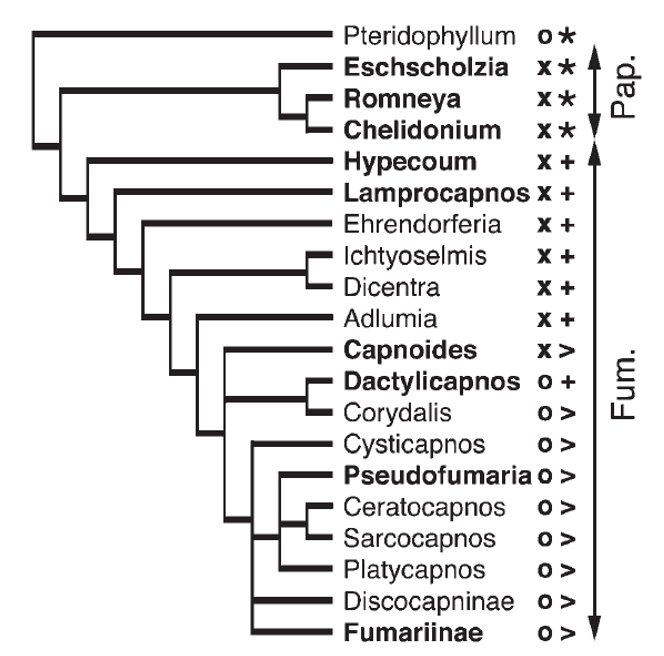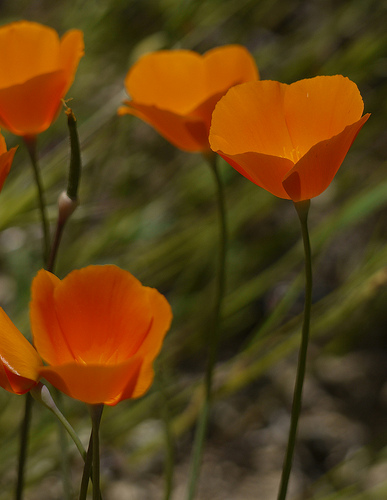Classification
Eschscholzia californica (Eh-schol-zia), or otherwise known as the golden poppy, flame flower, or cupa de oro, was discovered by Aldebert von Chamisso after observing fields and fields of the poppy in California (Smith 2010). If you break down the name Eschscholzia californica, Eschscholzia is named after a colleague of von Chamisso and californica means California (JSTOR Global Plants 2013). Johann Friedrich Gustav von Eschscholtz had such a lasting impact on Aldebert von Chamisso that this organism was named in his honor (JSTOR Global Plants 2013). To help better understand the breakdown of the lineages of E. californica, the Domain, Kingdom, Phylum, Class, Order, Family, Genus, and Species are described below.
Domain: Eukaryote
An organism that is eukaryotic has a membrane bound nucleus and is either single celled or muliticellular, like in the case of E. californica (The Free Dictionary 2000). Other organisms that are eukaryotic include the Bombardier Beetle, the Yellow Perch, and the American Black Bear.
Kingdom: Plantae (Smith 2010).
Organisms classified as Plantae are multicellular, have an alternation of generations life cycle, and use photosynthesis as their primary food source, making them autotrophic (Rothwell 2013). Another organism that would be in this kingdom would be the Miniature Lupine.
Photo courtesy of randomtruth.
Phylum: Magnoliophyta (Smith 2010)
The Magnoliophta phylum has many characteristics, including pollen deposition on stigmas, lack of gametangia on male and female gametophytes, and triple fusion of the egg (Takhtajan 2009). This phylum, also known as angiosperms, is the largest group of modern land plants and it is the greatest contributor of vegetation on the Earth's surface (Takhtajan 2009).
Class: Magnoliopsida (Smith 2010).
Flowering plants can be classified as either Magnoliopsida (dicots) or Liliopsida (monocot) based on several characteristics (Speer 2013). Monocots have parallel leaf venation, one cotelydon in the embryo, and lack secondary growth (Speer 2013). Dicots have reticulated leaf venation, two cotelydons in the embryo, and secondary growth (Speer 2013). Regardless of the various differences, the main way to determine if an organism is in the Magnoliopsida or Liliopsida class is the number of cotelydons in the embryo (Speer 2013).
Order: Papaverales (Smith 2010).
Papaverales can be broken down into four suborders, which are represented by six families, including the Papaveraceae (Johri et al. 1992). Some of the common characteristics of this order include pollen grains that are two celled, an endosperm that is nuclear in nature, and an anther tapetum that is secretory (Johri et al. 1992).
Photo courtesy of docentjoyce.
Family: Papaveraceae (Smith 2010).
Papaveraceae are typically perennial or annual herbaceous plants but can also be vines, trees, or shrubs that produce white, cream, or yellow colored sap containing alkaloids (Calandra 2002).
Genus: Eschscholzia Cham. (Smith 2010).
This genus consists of 13 species in western North America with elaborately diverse seeds (Clark and Jernstedt 1978). These elaborate, mature seeds can float on water due to air bubbles in the irregular outer surface of the seed (Clark and Jernstedt 1978). Another characteristic is the dispersal of the seeds. The capsules of this organism dehisce and the seeds are expelled a significant distance away from the parent plant (Clark and Jernstedt 1978).
Species: Eschscholzia californica Cham. (Smith 2010).
This species consists of two subspecies and three variations, which you will learn more about as you browse this website (Clark 2010).

This phylogenetic tree represents the relationships between common ancestors of E. californica. The (*) indicates similar petals, (x) indicates determinate inflorescences, the (o) indicates indeterminate inflorescences, the (+) indicates flowers that are bilaterally symmetric, and (>) indicates flowers that are transversely monosymmetric (Kolsch A. and S. Gleissberg 2006).

This phylogenetic tree represents the various subspecies and variations of E. californica which are further dicussed in Habitat (Smith 2010).


.jpg)